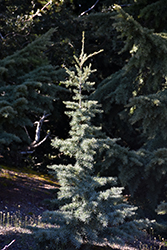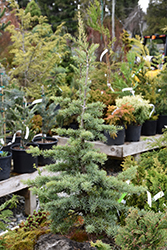It's all about ...
plants

Bump's Blue Mountain Hemlock
Tsuga mertensiana 'Bump's Blue'
Height: 10 feet
Spread: 4 feet
Sunlight:
![]()
![]()
Hardiness Zone: 6a
Description:
A narrow, dwarf selection with outstanding, bright, powder blue needles on an irregular, conical habit; blue-purple cones mature to brown; needs adequate moisture, rich, acidic and organic soils and shelter from drying winds
Ornamental Features
Bump's Blue Mountain Hemlock is primarily valued in the landscape or garden for its distinctively pyramidal habit of growth. It has attractive grayish green-variegated powder blue foliage with hints of silver which emerges chartreuse in spring. The glossy sprays of foliage are highly ornamental and remain powder blue throughout the winter. The indigo fruits which fade to brown over time are held in cones in mid fall.
Landscape Attributes
Bump's Blue Mountain Hemlock is an evergreen tree with a strong central leader and a distinctive and refined pyramidal form. It lends an extremely fine and delicate texture to the landscape composition which can make it a great accent feature on this basis alone.
This tree will require occasional maintenance and upkeep, and is best pruned in late winter once the threat of extreme cold has passed. Gardeners should be aware of the following characteristic(s) that may warrant special consideration;
- Insects
Bump's Blue Mountain Hemlock is recommended for the following landscape applications;
- Accent
- Hedges/Screening
- General Garden Use
Planting & Growing
Bump's Blue Mountain Hemlock will grow to be about 10 feet tall at maturity, with a spread of 4 feet. It has a low canopy with a typical clearance of 1 foot from the ground, and is suitable for planting under power lines. It grows at a medium rate, and under ideal conditions can be expected to live for 70 years or more.
This tree does best in full sun to partial shade. It does best in average to evenly moist conditions, but will not tolerate standing water. It is particular about its soil conditions, with a strong preference for rich, acidic soils. It is quite intolerant of urban pollution, therefore inner city or urban streetside plantings are best avoided, and will benefit from being planted in a relatively sheltered location. Consider applying a thick mulch around the root zone in winter to protect it in exposed locations or colder microclimates. This is a selection of a native North American species.
This plant is not reliably hardy in our region, and certain restrictions may apply; contact the store for more information.

